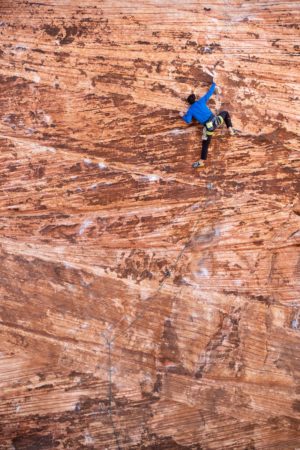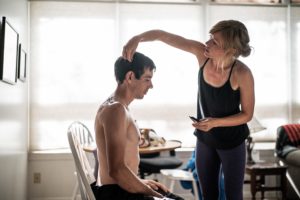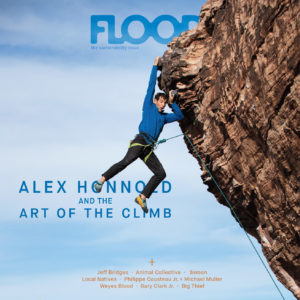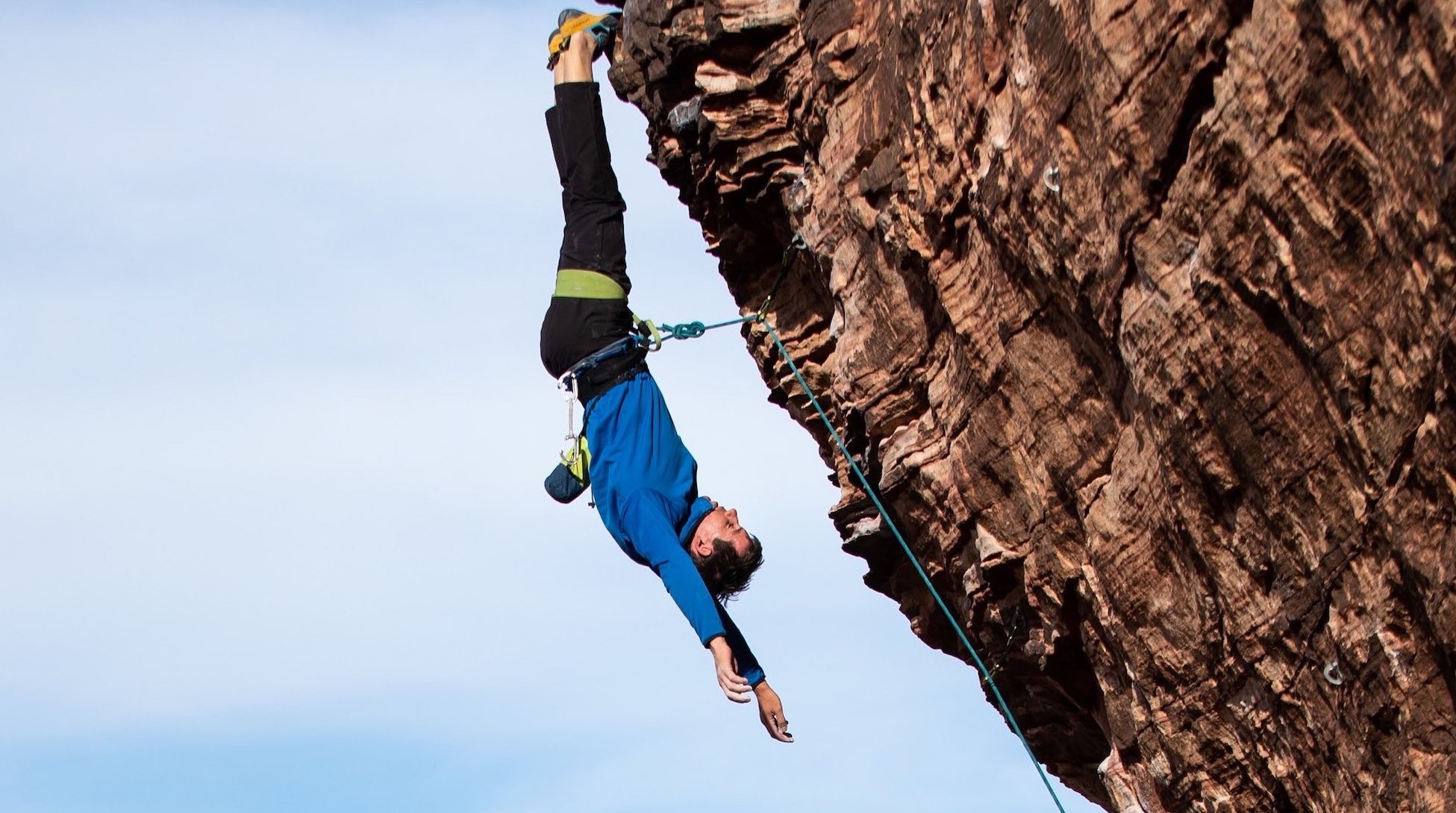This article appears in FLOOD 10. You can purchase the magazine here.
Adam Ondra screams as he hops from rock to rock like some kind of lunatic spider and Tommy Caldwell presses his body up against bluffs with twitchy limbs and obvious nerves, but Alex Honnold’s climbs are deliberate and quiet. He slides his palms over stones like you might cup a lover’s thigh, hands roughly the size of two pale catcher’s mitts.
Alex says that Ondra is the best climber in the world—but it was Alex, not Ondra, who was the subject of the film that took home Best Documentary at this year’s Academy Awards.
Directed by married pair Jimmy Chin and Elizabeth Chai Vasarhelyi, Free Solo tails Honnold’s two-year journey toward becoming the first person to ascend El Capitan, a three-thousand-foot wall of granite in Yosemite National Park, without the help of ropes or safety equipment. The film’s crew—many of them friends of Alex and experienced climbers themselves—watched him with gritted teeth and severe misgivings about whether taping the climb could make their friend lose focus and fall.
“So delighted,” is what the Sacramento-bred athlete said upon reaching the summit after four hours without plunging to a grisly death. His voice is deep and croaky like the beginnings of a burp, and he’s clad compulsively in his primary sponsor, The North Face. Clif Bar used to be a sponsor too, but the company dropped him after deciding free soloing was too dangerous a sport to fund.
 The climber’s modest home sits on a street lined with near-identical peach-colored homes in a Las Vegas suburb. The signature white van—lived in by Alex for nine years while he “dirtbagged” across the country, and inhabited part-time by his girlfriend Sanni McCandless in the documentary—is parked in the driveway. Sanni shares this house with Alex too, though they both travel so much an elderly neighbor has to collect their packages.
The climber’s modest home sits on a street lined with near-identical peach-colored homes in a Las Vegas suburb. The signature white van—lived in by Alex for nine years while he “dirtbagged” across the country, and inhabited part-time by his girlfriend Sanni McCandless in the documentary—is parked in the driveway. Sanni shares this house with Alex too, though they both travel so much an elderly neighbor has to collect their packages.
Sanni has dent-in-cream dimples and she’s giving Alex a haircut in the backyard when I arrive. After that, she heads to the supermarket for seven hungry visitors who are spending the weekend, all board members of the Honnold Foundation. It’s a nonprofit started by Alex, dedicated to bringing solar energy to communities around the world.
The full board is meeting for the first time here in Vegas, where Honnold lives because it’s cheap, non-trafficky, and has easy access to four-season outdoor play. He only visits the strip once or twice a year; far more frequently, he heads to the crumbled cinnamon cliffs of Red Rock Canyon just outside the city, where the board is joining him for a climb today.
“The Honnold Foundation began because I wanted to donate my own money to environmental projects that I cared about,” Alex explains as we sit in the white-glare Nevada sun, interrupted only by board president Maury Birdwell throwing eggshells in the garbage; Alex gets up and directs him to the compost pile instead. “The question was whether I should do it in a public or private way. I could’ve donated privately, but I felt like the one thing I could contribute is that I’m a public figure, to some extent, and can potentially rally funds for the cause—even though it feels slightly douchey, making it public.” He pauses politely before saying “douchey” to ask me how fancy this publication is.

It’s funny how wrong people are about Alex Honnold. Most assume he’s a hardened risk-taker or adrenaline junkie who cackles in the face of danger, but his famed free solo climb was as precise as a robotic surgery, as choreographed as Swan Lake. He prepped for years, scaling El Capitan with ropes over and over until he knew every move by heart. Alex is fond of pointing out that unlike football or boxing—both of which prompt myriad brain injuries—free soloing is comparatively safe, up until that one fatal misstep. And such a misstep might never come.
“If you learn one thing from climbing, it’s that you never conquer nature. Nature always conquers you. No matter how great you feel as a climber, all it takes is one event to remind you that you’re an insignificant piece of dust.”
Big wall free soloing is the easiest type of climbing to sell, but not the hardest to do, Alex will be the first to admit. Fans see him clinging to a rock, inches from death, and without knowing anything else about the sport, they are hooked. But Alex doesn’t always climb without ropes. On the contrary: he mostly climbs with them. Even accompanied by all the trappings of safety gear, there are dangers; a knot untightens, a bolt pulls out, a hold breaks, a storm makes terrain slippery, a bat flies out of a hole and surprises you. From two thousand feet up, Alex would fall for over ten seconds before hitting the ground. That’s enough time to contemplate all the things that make life worth living.
There’s something almost holy about climbing so high. Like Icarus’ wings melting in the sunshine or the Tower of Babel creeping skyward until it was dismantled by an angry God, Honnold seems to be tempting fate. “When he’s free soloing is when he feels most alive,” Alex’s mother protests in the documentary. “How could you even think of taking that away from somebody?”
I ask Alex whether scaling an inhospitable rock quenches some conqueror urge inside of him. Surviving these climbs is, technically, like trouncing Mother Nature. “If you learn one thing from climbing, it’s that you never conquer nature,” he laughs, dismissively. “Nature always conquers you. No matter how great you feel as a climber, all it takes is one event to remind you that you’re an insignificant piece of dust.”

Alex free soloing El Cap / photo by National Geographic + Jimmy Chin
In 2016, Alex got an MRI at the Medical University of South Carolina in Charleston. Psychologists and neuroscientists were interested to know how “high sensation seekers” like him processed fear, and found Alex’s amygdala (the brain’s fear center) to be perfectly healthy—though it lit up far less frequently in response to disturbing or exciting images than an average person’s does. Honnold suspects his threat-response has been neutered over time, with thousands of hours spent in danger zones. Unsurprisingly, in these tests Alex also scored high in conscientiousness and premeditation, but low in neuroticism. He doesn’t replay scenarios in which he might perish in his head, or obsess over what could go wrong.
Honnold isn’t a fiction reader (he prefers non-fiction) and hates both comedies and most horror films (he doesn’t enjoy “being tricked” by jump scares, he says). His ideal movie is something “upbeat and action-packed.” In attendance at this year’s Oscars, Alex told a producer of BlacKkKlansman that he liked Spike Lee’s film, but thought it was half an hour too long.
When I suggest his lack of trepidation in free soloing might correspond to a lack of imaginative sensitivity—at least the kind typical of those affected by scary films and fiction—Alex is resistant. “I can be imaginative and thoughtful without being neurotic,” he insists.

Honnold sometimes struggles with empathy, something he freely admits. He’s sympathetic in spades, but it’s harder for Alex to step outside of himself. When I accompany the board to Red Rock, Alex encourages me to climb for the first time (surprise: I am not very good) and later asks if I’m now going to become a climber. I very much enjoy watching others do it, I tell him—but some people’s bodies just aren’t built for feats of athleticism. He disagrees. People can train their bodies to do anything.
“Could you do ballet?” I ask, thinking I’m making a sound point about varying capabilities. He sticks his arms out and pliés a few times, toes pointed in soft climbing shoes. He definitely could, he says.
Sanni is the empathetic one, as evidenced by Free Solo. She’s the eternal optimist and he’s the cynic, the kind of guy who requires a patient girlfriend, and one who can handle him risking his life for sport. He has a sarcastically blunt way of speaking, and some viewers have criticized his description of Sanni in the doc as being “cute and small” and not taking up “too much room” in his bachelor van.
“I might not like the way I’m portrayed—actually, I don’t really care,” Alex tells me of Free Solo, “but whether I like it or not, I think it’s fair. There are certainly scenes where I’m like ‘Man, I’m such a dick.’ But if you watch anyone for two years, they’re going to be a dick sometimes. I’m also more harsh in the film than in real life. Having a camera on you all the time adds extra stress. You constantly feel like you’re being watched.”
I don’t see him as inconsiderate. “Follow your heart,” I hear Alex advise Sanni when she says she’ll cook him an egg for breakfast, which could be perceived as condescending—but I can tell it was not intended as such. Alex is someone learning intimacy, while Sanni is a born nurturer.

Alex and girlfriend Sanni McCandless / photo by National Geographic + Jimmy Chin
Alex got into free soloing because he was too shy to find belay partners as a kid, and he taught himself to hug at the age of twenty-three because no one in his family had ever showed physical affection; they didn’t even use the word “love.” Alex’s father was morose when Alex was growing up (he would probably be diagnosed with Asperger’s today, Alex’s mother says). Pre-divorce, their marriage was an unhappy one, and he died when Alex was nineteen.
After his father’s death, Alex dropped out of UC Berkeley to begin climbing full-time. He’d grown up idolizing ropeless alpinists like Peter Croft, a legend of the ’80s who appears briefly in Free Solo to give Honnold some advice: “You made a perfect choice,” Croft, then in his late fifties, tells Alex after he attempts to free solo El Cap once, but bails because the conditions don’t feel right. His second attempt is the victorious one.
In the movie, Alex’s mom Dierdre Wolownick is vaguely described by her son as a sort of critical perfectionist. Nothing he did was ever good enough for her. “If you’re seeking perfection, free soloing is as close as you can get,” Honnold says, revealing an early seed. It’s the truth about this weird and wonderful accomplishment: one wrong move and you perish, but do it perfectly, and you’ll access the sublime.
Wolownick began climbing in her fifties, and has since scaled El Capitan (using ropes) with the help of her son. She recently wrote a book about her experience as the oldest woman to summit the wall, though Alex isn’t sure whether that claim is precisely true. “I don’t know if it’s brought us closer, but she does have a better sense of what I’m doing,” he tells me of their climb. He hasn’t read the book yet.

As the story goes, Alex and his longtime climbing buddy Maury Birdwell were gabbing in the car on their way back from a climbing trip in 2012 when the idea for the Honnold Foundation was born. On an African climbing expedition with North Face two years prior, Alex had seen villagers living without electricity; so with Maury, he decided to combine his passion for fighting climate change and poverty in one fell swoop, using his philanthropic inclinations to promote solar energy.
There are one billion people on earth currently living without access to power, but our sun might hold a solution: renewable energy that won’t run out for another five billion years. A resource for producing sustainable electricity with far less toxic pollutants and global warming emissions.
Since its inception, the Honnold Foundation has operated as a donor-advised fund under the Tides Foundation, but this past year they became an independent 501(c)(3) public charity with more operational freedom. They are best described as an intermediary between donors and nonprofits, using Honnold’s clout in the outdoor community to support pre-existing work from organizations like SolarAid, GRID Alternatives, and the Solar Energy Foundation, to name a few. When his foundation began, Alex was funneling in a third of his income. At this point he’s worth an estimated two million, and one-third is a number he says he’d like to return to.
“The easiest way to think about it is: imagine living without light. Especially if you’re in the tropics, that’s twelve hours of darkness a day. Not a lot of time to learn how to read, do your homework, do productive things we take for granted.”
“The easiest way to think about it is: imagine living without light,” Alex explains with the same placid practicality he applies to climbing. “Especially if you’re in the tropics, that’s twelve hours of darkness a day. Not a lot of time to learn how to read, do your homework, do productive things we take for granted. In East Africa, people spend up to a quarter of their income just on kerosene to light their homes. If you don’t have that much money to begin with, that’s a tremendous amount, combined with the health detriments of burning kerosene in a confined space. People are poisoning themselves to light their home in a very inefficient way. Solar lanterns and LED lights are an elegant solution to that problem.”
Solar panels can cut a home’s utility bill in half, though there is a sizable upfront cost, and not everyone knows about the myriad benefits: Solar panels work even in cloudy places like the Pacific Northwest, they are less vulnerable to extreme weather than our current systems, and the panels last for thirty years. While Alex does not claim to be an expert on any of this—more of an “enthusiastic hobbyist”—he’s installed solar panels on the homes of his mom and multiple friends, and sometimes loans people money for their initial installation costs. “Almost every solar installer will lease you a system for less than your utility bill,” Alex assures me.
He’s been noticing more solar panels cropping up around Vegas on his bike ride to the climbing gym, and is confident solar will become ubiquitous in ten years’ time. “Renewable energy is bipartisan—even the most conservative people appreciate the idea of generating their own energy,” he says. “It’s a very democratic, fair way of powering a society.”
 HF board member Len Necefer used to work for the U.S. Department of Energy, but left following Trump’s election (“The policy of the administration now is energy dominance, which basically means fossil fuels at any cost,” he grumbles) and Necefer concurs that saving money should be a politically agreeable position. “Some rural communities in Kansas are very Republican, for example—and they’ve supported solar and energy efficiency because it makes sense economically,” Necefer tells me, though he admits that renewable energy is commonly conflated with environmentalism, and that’s what turns some people off. “Go figure,” he adds dryly.
HF board member Len Necefer used to work for the U.S. Department of Energy, but left following Trump’s election (“The policy of the administration now is energy dominance, which basically means fossil fuels at any cost,” he grumbles) and Necefer concurs that saving money should be a politically agreeable position. “Some rural communities in Kansas are very Republican, for example—and they’ve supported solar and energy efficiency because it makes sense economically,” Necefer tells me, though he admits that renewable energy is commonly conflated with environmentalism, and that’s what turns some people off. “Go figure,” he adds dryly.
The foundation’s only full-time staffer is Executive Director Dory Trimble, who learned what it’s like to live without power firsthand during her time stationed in the Dominican Republic with the Peace Corps. Without access to refrigeration, fresh food went bad; in searing heat, the dearth of air conditioning was crippling; when cell phones and computers could not be charged, communication became impossible.
“Energy access work is like social justice work,” Trimble says. “The people who are most affected by it are the people who are the most traditionally marginalized. And it isn’t really sexy the way other development questions are. It often shows up as a second order need. I think it gets less attention because it’s so fundamental—people forget it exists.”
 The Honnold Foundation member who knows Alex best is co-founder Maury, now serving as president. Maury appeared on camera in Free Solo, but ended up on the cutting room floor; he was a little disappointed there wasn’t more talk of the foundation in the doc, though he understands it was chopped for narrative tightness. Alex and Maury have a playful relationship—Maury delights in proving Alex wrong whenever he can, but he is also tenderly impressed by his friend’s progress.
The Honnold Foundation member who knows Alex best is co-founder Maury, now serving as president. Maury appeared on camera in Free Solo, but ended up on the cutting room floor; he was a little disappointed there wasn’t more talk of the foundation in the doc, though he understands it was chopped for narrative tightness. Alex and Maury have a playful relationship—Maury delights in proving Alex wrong whenever he can, but he is also tenderly impressed by his friend’s progress.
“I have a low threshold for things that I perceive as inauthentic,” he tells me. “That’s kind of why I’ve been drawn to working with Alex—authenticity is one of the values that resonates deepest with him. And I don’t think we’re preachy in our message, we’re just trying to do good things, and we’re not saying we have the best answer, but we’re making the effort. Alex isn’t dogmatic or declaratory—he just says, ‘We’re doing our best.’ He’s also a dick. Very matter-of-fact. His upbringing didn’t necessarily give him the tools. But he’s learned them.”

On our day at Red Rock, Alex climbs a little, but mostly acts as a patient belayer for the other board members. At one point he leads a quick group climb he claims will be a 5.4 grade difficulty, but expert climber and board accountant Nancy Feagin informs everyone it was more like a 5.6, which is a good amount steeper. To Alex, everything is no big deal.
He explains how climbing is much more social than people realize: a large part of it is hanging out, shooting the shit with your friends or kindly strangers. When he climbs, people pay attention—a small group of bystanders collect nearby to watch. Alex falls several times, but the ropes catch him. When that happens, he pushes himself off the rock with his feet and dangles like a kid on a swing, contented in midair.
It’s startling to hear people fall. There are lots of climbers outside Vegas that day, amongst the tawny mountains and scratchy shrubs, scrambling up and down low-lying sand-smooth rocks. Their falls are halted by ropes, but sometimes they fall kind of far. Sometimes they yell. Alex has seen someone die at Red Rock; he wasn’t close enough to witness the accident itself, but he heard screams for help and later saw a man bleeding out at the bottom of a cliff.
And yet, he still comes. He knows what might happen, but he keeps coming.
Board member Peter Martin and his wife Emily are there with us too, and Peter loses his wedding ring on the group climb. The ring was pocketed beforehand, but tumbled out when Peter reached the summit, so we all search through brush that is crawling with caterpillars and study complex patterns in the rock faces trying to discern a tiny silver band. In the end, Emily finds it—the ring bounced much farther than Alex told us it should have, Maury points out, ever eager to one-up his pal.
In Alex’s world, it could have been worse: he had a friend who lost a thumb while scaling The Nose of El Capitan, he tells us. But they found the thumb, and sewed it back on. Alex perceives that as a pretty happy ending. FL










